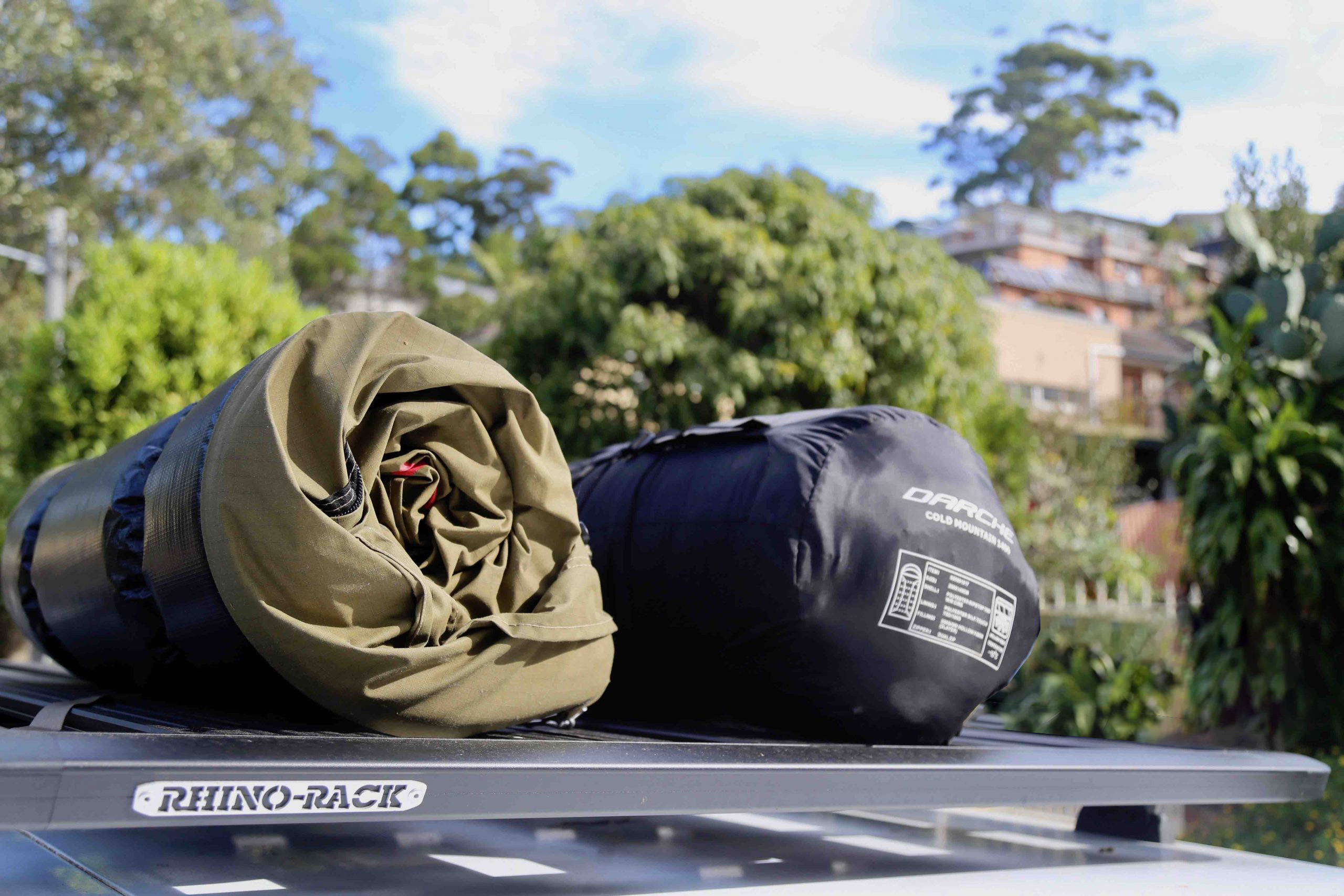Choosing and fitting a Rhino-Rack All New Pioneer rooftop platform.

Rooftop storage is a big deal. The space up top of your rig is valuable real estate and there’s several ways to go about using it to its maximum capacity
I intentionally bought a single cab Toyota HiLux with a massive 2.4m long canopy because I wanted to be able to fit a lot of accessories, build a sleeping setup within the canopy and still have plenty of storage space up top for carrying additional bulky touring gear.
I’d initially toyed with the idea of fitting a rooftop tent above the canopy, but soon realised that the more versatile and efficient use of space was to fit a modern low profile rooftop platform.
LOW PROFILE V BASKET?

After analysing the various platforms on the market, I realised that a lightweight, low profile setup would be most suitable. After all, this rig is my daily driver.
It’s just as important for the build to remain practical for day-to-day errands around town as when packed to the rafters for offroad getaways.
It’s an inevitability that any rooftop platform will impact noise and fuel economy to some degree. However, choosing a well-designed low profile setup will mitigate both of these potential issues significantly.
A lightweight, flat platform will drastically outperform any of the bulky basket style designs when it comes to ease of use, noise reduction and efficiency.
Loading and unloading heavy and unwieldy gear like surfboards, kayaks, canoes and fishing rods is always an easier job atop a flat platform.
Plus, opting for a level design meant I could avoid adding unnecessary additional overall height to the rig.
The idea here being that it’d be nice to still have the option of squeezing into the local Bunnings parking lot when the roof isn’t fully laden (suspension lift and tyre upgrade mean that the old girl is already riding more than a few inches taller than stock).
RHINO-RACK PIONEER PLATFORM

After weighing up the pros and cons of a handful of potentially suitable low profile style racks, the Rhino-Rack All New Pioneer Platform was the clear standout.
Rhino-Rack has been in the game for a hot minute. They’ve been manufacturing roof racks for three decades at this point, and their ultra popular Pioneer systems were first introduced back in 2010.
I’m a big fan of sticking with tried and true designs. If a particular design has been on the market for more than a few years, particularly in the fickle Australian 4WD sector, it’s gotta have a lot going for it.
With more than a decade on the market, there’s been ample opportunity for Rhino’s R&D team to perfect their product.
The current All New Pioneer is a sleek and highly refined platform. It’s constructed from aluminium with fibreglass reinforced nylon corners. It’s strong and durable, yet remarkably lightweight.
Due to the large surface area of my 2.4m canopy, and the comparably tiny roofspace of the HiLux’s single cab, I opted for a 2128mm X 1426mm All New Pioneer platform fitted atop the canopy via a set of Rhino-Rack’s RLT600 legs, which affix directly to the canopy roof.
The setup looks fantastic and offers the lowest possible profile, with an overall vehicle height increase of just 115mm.
VERSATILITY
One of the biggest selling points of the All New Pioneer platform is its versatility. The platform incorporates accessory channels into the front and rear extrusions, making mounting accessories a breeze.
There are also additional mounting channels on the underside of the platform at the front and rear, which are ideal for mounting LED lighting.
I’ll be fitting up a 40” slimline LED lightbar on the underside of the front of the platform as well two four-inch LED worklights on the underside of the left and right side of the platform to be used for camp lighting.
The platform features integrated wiring channels within all extrusions, meaning that the soon-to-be-fitted front lightbar and LED worklights can be wired up neatly with cables out of sight and protected from the elements.
COMPATIBILITY

Rhino-Rack claims the All New Pioneer is the most modular platform on the market, and when you take a look at the list of available accessories, it’s hard to argue.
All Rhino-Rack accessories are compatible with the platform, including recovery track mounts, jerry can holders, gas bottle holders, Batwing and Sunseeker awnings, folding ladder plus specific kayak, ski and bike carrier accessories and many more.
I love the fact that you can set up the All New Pioneer to carry just about anything. Whatever your lifestyle, the All New Pioneer can make it happen.
I’ll be hitting the road later in the year on a couple of big interstate fishing trips, so need to fit a roof-mounted rod holder to store a bunch of surf fishing rods plus a long-handled gaff.
Rhino-Rack has a range of compatible fittings, clamps and brackets that allow you to mount a conduit tube either on top or to the side of the platform. They’ve even got a selection of lockable end caps to provide additional security for your gear.
I’m thinking of fitting up a 270-degree awning like the Batwing in the future, but for the time being fitted up a two-metre XTM side awning I had lying around with no compatibility issues whatsoever.
MOUNTING

Rhino-Rack have an extensive Australia wide dealer network where you can purchase products and have a range of products installed on your vehicle. To find your nearest Rhino-Rack dealer visit https://www.rhinorack.com/en-au/where-to-buy.
The platform is attached to the canopy via three of Rhino-Rack’s Quick Mount RLT600 legs on each side.
The Quick Mount legs offer the option to quickly and easily remove the entire roof platform when not needed via a simple trigger locking system. This could certainly come in handy from time to time for low clearance situations.
The RLT600 legs are tested to AS1235:2000 (Australian) and ISO11154:2006 (City Crash/ International) standards.
ROOFTOP LOADS
Rooftop load ratings can be a complicated business. It’s an issue that can leave plenty of punters confused and potentially ending up with the wrong roof rack or platform setup for their needs.
Thankfully, Rhino-Rack have helped lay out the most important principles to keep in mind online with several resources including their Load Rating Calculator and Load Ratings Explained guide.
If you’re in the market for a new rooftop platform, or are considering upgrading your rig’s top level storage setup, the first figure you’ll need to know is your vehicle’s roof load rating.
This figure should be easy enough to find in your owner’s manual, or via a quick Google search.
It’s important to remember that your vehicle can handle vastly different loads in different situations. The different types of rooftop loads that matter for each vehicle are its onroad roof rating, its static roof rating and offroad roof rating.
An onroad rating refers to the load a vehicle’s roof can bear when travelling on a sealed road, whereas its static rating refers to the load that can be borne atop a stationary vehicle. The static rating will be most important to rooftop tent users.
Lastly, an offroad rating refers to the load that can be carried atop a vehicle travelling on an unsealed road without a surface protection layer.
Loads transferred to a vehicle’s roof while travelling offroad are considerably greater than while static or while driving on sealed surfaces.
Rhino-Rack suggests reducing rooftop loads by one third when travelling offroad.
The canopy on my HiLux has a roof load rating of 100kg. After deducting the weight of the All New Pioneer platform itself (32.4kg), I can safely load up with 67.6kg of cargo when sticking to sealed surfaces.
When heading offroad I’ll need to reduce this by a third in order to stick below my setup’s offroad rating.
Considering the fact that I’m mostly concerned with carrying bulky yet relatively lightweight gear like surfboards, fishing rods and swags up top, I shouldn’t see any need to get close to surpassing the rack’s safe offroad rating.
VERDICT
I couldn’t be happier with the fitment and appearance of the All New Pioneer platform on the ‘Lux. It’s sleek and well designed and doesn’t get in the way when driving about town.
It’s incredibly versatile and allows for fitment of all sorts of touring necessities, some of which, i.e. lightbars, worklights and awning, will remain bolted up top year round.
Other items like my fishing rod tube, MAXTRAX, jerry can and gas bottle will only be mounted for certain trips and can be taken down and stowed in the garage the rest of the year,
This setup offers the best of both worlds. It does everything I could want from it in terms of mounting touring gear, offroad accessories and bulky extras that I can’t fit within the canopy and still want to cart about on fishing and camping trips.
The rack doesn’t get in the way, create excess noise or noticeably impact fuel efficiency for day-to-day use.
A great looking, ultra capable rooftop platform for the daily driver x dedicated tourer.

















